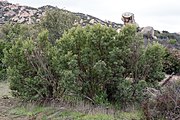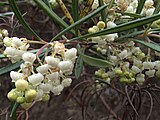
Primula clevelandii, with the common name of Padre's shooting star, is a species of primrose.

Agave shawii is a species of monocarpic succulent plant in the genus Agave, commonly known as Shaw's agave. It is a rosette-forming plant characterized by glossy, green leaves with toothed margins. After several years of slow growth, the plant puts all of its resources to produce a towering stalk of flowers, and then dies. The death of the flowering rosette is compensated by the growth of numerous clonal pups. This species is segregated into two subspecies, one native to the coast of southwestern California and northwestern Baja California, known commonly as the coast agave, and another native to the Baja California desert, known as the Goldman agave.
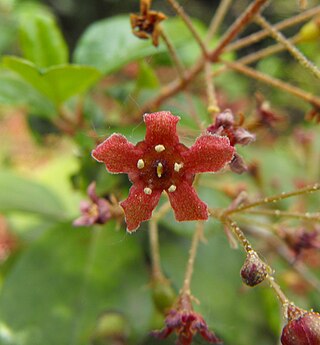
Ribes viburnifolium, is an uncommon North American species in the gooseberry family. It is known by the common names Catalina currant, Santa Catalina Island currant, island gooseberry and evergreen currant.
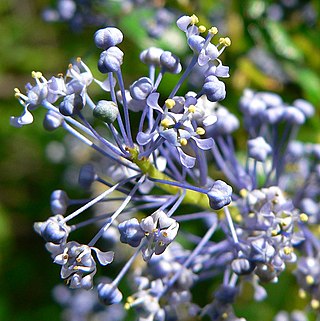
Ceanothus cyaneus is a species of flowering shrub in the genus Ceanothus known commonly as the San Diego buckbrush and Lakeside ceanothus. This species is found in the Peninsular Ranges of San Diego County, California, and known from one occurrence in Baja California. It is characterized by brilliant blue flowers, glossy green foliage, and is regarded as one of the most beautiful members of the genus.

Euphorbia misera is a semi-succulent shrub in the genus Euphorbia commonly known as the cliff spurge or coast spurge. A drought-deciduous shrub, it is typically found as a gnarled, straggly plant occupying seashore bluffs, hills and deserts. Like other members of its genus, it has a milky sap, which can be found exuding out of the light gray bark when damaged. The alternately-arranged leaves are round and folded in the middle, with small hairs on them. The "flowers" can be found blooming year-round, and are colored maroon or yellow in the center with 5 white to light-yellow petal-like appendages attached outside. This species is native to the Baja California peninsula and Sonora in Mexico, and the coast of southern California in the United States, where it is a rare species. It is threatened in some localities by the development of its coastal habitat, which tends to be prime locations for high-end residential and commercial developments.

Jepsonia parryi is an uncommon species of flowering plant in the saxifrage family known by the common names coast jepsonia and Parry's jepsonia. It is a small geophytic plant that flowers briefly during fall, and often only has a single leaf that may appear above the ground after or during flowering. It is native to the coast and inland hills chaparral of southern California and Baja California.

Camissoniopsis bistorta is a species of flowering plant in the evening primrose family known by the common names southern suncup and California suncup. It is native to southern California and Baja California, where it grows in several types of plant community along the coast and in the coastal hills and mountain ranges. This is a hairy annual or short-lived perennial herb spreading from a basal rosette, with stems reaching up to 80 centimeters long. The leaves are narrow and sometimes toothed, and 1 to 12 centimeters in length. Toward the end of the spreading stems are nodding inflorescences of flowers, each flower with four bright yellow petals dotted with red at their bases.
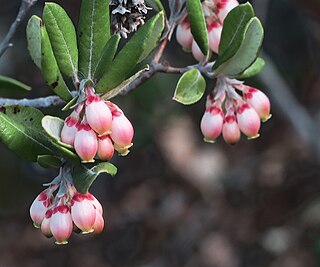
Xylococcus is a monotypic genus of flowering plants in the heather family which contains the single species Xylococcus bicolor, commonly known as the mission manzanita. It is a burl-forming, evergreen shrub with leathery leaves and smooth dark reddish bark. From December to February, white to pink urn-shaped flowers adorn the foliage, often attracting hummingbird pollinators. It is native to southern California and the Baja California Peninsula, south to the Sierra de la Giganta. There is growing concern over the future of this plant, referred to as the "queen of the elfin forest, " as it may possibly lose up to 88% of its habitat and its wild seedlings are failing to survive more than a full year.

Ceanothus verrucosus is a species of shrub in the family Rhamnaceae known by the common names wart-stem ceanothus, barranca brush, coast lilac and white coast ceanothus. It is endemic to northwestern Baja California and San Diego County, where it grows in coastal sage scrub and coastal succulent scrub habitats. It is considered a rare species north of the international border, as most of the valuable coastal land that hosts this plant in the San Diego area has been claimed for development. In California, several extant populations still remain scattered around the region, such as one protected at Torrey Pines.

Hooveria parviflora is a species of perennial herb in the subfamily Agavoideae known by the common name smallflower soap plant. It is a monocot, native to coastal southern California and Baja California, where it is a member of the coastal sage scrub flora. It resembles a smaller version of Chlorogalum pomeridianum, with wavy leaves and white flowers that open during the day.

Comarostaphylis diversifolia, known by the common names summer holly and California comarostaphylos, is a species of shrub in the heath family.

Dudleya variegata is a deciduous succulent plant in the family Crassulaceae known by the common names variegated liveforever, variegated dudleya or rarely San Diego Hasseanthus. A cryptic plant that survives part of the year dormant underground from starch reserves in a corm, after sufficient rainfall, leaves will emerge, soon giving way to small inflorescences with yellow star-shaped flowers. It is native to Baja California and adjacent San Diego County in California, where it grows in several habitat types, including chaparral and vernal pools.
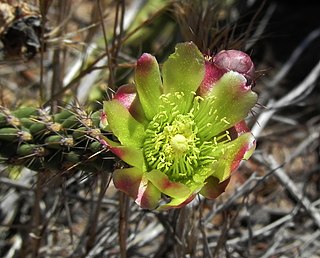
Cylindropuntia californica is a species of cholla cactus known by the common name snake cholla. It is primarily found in Baja California, Mexico and the southernmost part of California in the United States. It is characterized by a short, decumbent habit, yellow-green flowers, elongated stems, and short spines. It is mostly found in coastal sage scrub and coastal chaparral habitats, but two varieties in Baja California can be found in foothills and deserts. In California, variety californica is regarded as a rare and threatened plant, with a California Native Plant Society listing of 1B.1, in part due to its limited number of occurrences and threats from development. It formerly was considered to have a larger range due to the inclusion of Cylindropuntia bernardina within it as the variety parkeri.

Ribes canthariforme is a rare species of currant commonly known as the Moreno currant. It is characterized by pink to red flowers, a dense inflorescence, and a lack of nodal spines. A little-known endemic to the mountains of San Diego County, it is usually found growing the shade of massive boulders in the chaparral. Although the rarity and small numbers of this plant is a conservation concern, it is usually found in remote areas and is well hidden enough to be safe from most threats.

Salvia munzii is a semi-evergreen perennial species of sage known by the common name Munz's sage or San Miguel Mountain sage. It is native to northern Baja California, Mexico, and it can be found in a few locations just north of the border in San Diego County, California, where it is particularly rare. It is characterized by small leaves and clear blue flowers. It is a member of the coastal sage scrub and chaparral plant communities.
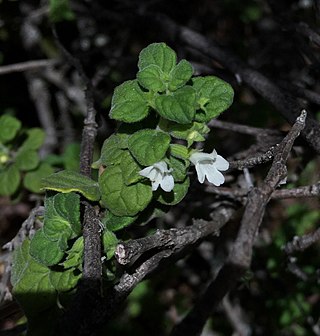
Clinopodium chandleri is an uncommon species of flowering plant in the mint family known by the common name San Miguel savory. It is native to northern Baja California and several areas of southern California, where it can be found in mountain chaparral. A fragrant plant with white flowers, it is one of southern California's rarest shrubs.

Dicranostegia is a monotypic genus of hemiparasitic flowering plants belonging to the family Orobanchaceae, containing the species Dicranostegia orcuttiana, commonly known as Orcutt's bird's beak or Baja bird's beak. It is near-endemic to Baja California, found from Miller's Landing north to Tijuana, but has a few occurrences in southern San Diego County, California. It is differentiated among other similar species in California by its leaves with 8 to 11 lateral lobes that are paired. It was formerly placed in the genus Cordylanthus until phylogenetic analysis led to it being split off. This species is threatened by the destruction of its habitat from urbanization.
Arctostaphylos bolensis is a species of perennial shrub in the heather family commonly known as the Cerro Bola manzanita. This species of manzanita is characterized by an erect habit, pendent panicles and the lack of a burl. It is a prolific bloomer, and when in blossom, it is enshrouded in white to pink urn-shaped flowers. This species is endemic to the Cerro Bola, and possibly the Cerro Italia, two mountain ranges southwest of the Valle de Las Palmas in northern Baja California.

Convolvulus simulans is a species of annual plant in the morning glory family known as the small-flowered morning-glory and small-flowered bindweed. It is an inconspicuous vining plant that is characterized by tiny pale pink or pale blue bell-shaped flowers. It is typically restricted to clay and serpentine substrates in annual grassland, coastal sage scrub and chaparral habitats. This species is native to Arizona, California, and Baja California. Some taxonomies place this species under Convolvulus equitans.
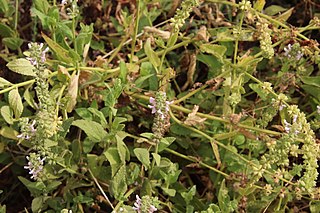
Stachys stebbinsii is a species of perennial herb in the mint family commonly known as Stebbins' hedgenettle. This plant is characterized by a musky aroma, flowers with large lower lips, and glandular hairs that densely cover the stems. S. stebbinsii is native to California and northwestern Baja California. It is usually found growing in moist places in a wide variety of habitats including disturbed areas, chaparral, coastal sage scrub and mountains.




